
Features
Operations
Yukon’s aerial economic catalyst
Canada’s far northwest corner has challenged entrepreneurs for centuries. Yukon’s bounty of natural resources has tempted many to head up there in search of golden opportunities.
March 7, 2013 By Frederick K. Larkin
Canada’s far northwest corner has challenged entrepreneurs for centuries. Yukon’s bounty of natural resources has tempted many to head up there in search of golden opportunities. Between 1896 and 1899, the Klondike Gold Rush saw about 100,000 prospectors travel to the area around Dawson City. The community’s population exploded from 500 to almost 40,000 during that period. By 1902, that wave of humanity had receded to 5,000. Some 111 years later, it stands at 2,000.
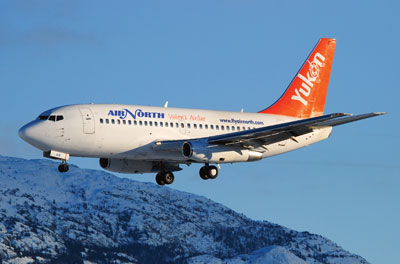 |
|
| Air North operates a fleet of 10 aircraft, consisting of two principal types: five Hawker Siddeley HS-748 turboprops and five Boeing 737 jets. PHOTO: Simon Blakesley
|
With a landmass of almost 500,000 square kilometres, Yukon is roughly the size of Spain. Approximately 36,000 people live there, 27,000 of whom reside in Whitehorse. While they may be remotely located and few in number, Yukoners are productive.
The territory’s gross domestic product (GDP) grew 5.6 per cent in 2011, far exceeding Canada’s national growth rate of 2.6 per cent. In fact, 2011 was Yukon’s eighth consecutive year of GDP growth. Having seen the price of gold more than double over the past five years, it shouldn’t be a surprise that gold-related work currently represents about 70 per cent of the mining industry’s exploration activity within the territory. Construction and tourism also contributed to Yukon’s impressive economic performance that resulted in an unemployment rate of 6.0 per cent at the end of 2012 compared to 7.1 cent for the nation.
During the past 85 years, air transport has played a key role in the development of Yukon’s economy. It began on Oct. 25, 1927 when a Ryan B-1 Brougham of The Yukon Airways and Exploration Company arrived at Whitehorse. Since then, many charter firms have come and gone. Scheduled carriers have also found it difficult to achieve longevity. From 1935 until 1970, operators including British Yukon Navigation, Northern Airways, Yukon Southern Air Transport, Canadian Pacific Air Lines, Connelly-Dawson Airways and Great Northern Airways provided sked services across Yukon. Unfortunately, financial issues forced them to either retreat from the territory, merge with a competitor or shut down.
More recently, one airline has been able to gradually expand its network throughout the region, as well as to the south, thereby becoming an important economic conduit. Air North has provided scheduled services for most of its 36 years and has so far survived the same economic downturns that have doomed numerous larger Canadian airlines in more southerly climes.
Given the slow rate of recovery underway in the North American economy, can this plucky independent continue to prosper?
Before we attempt to answer that question, it is useful to review how the company got to where it is today.
That was then . . .
Joseph T. Sparling, an aspiring commercial pilot, and Thomas A. Wood, an aircraft maintenance engineer, identified an opportunity to build an aviation business in Whitehorse. On Feb. 1, 1977, they purchased a financially challenged outfit called Globe Air Services Ltd. and renamed it Air North Charter and Training Ltd. Starting with a Cessna 206, “C-GLIZ,” they flew charters for mining companies and later provided flight training. The fleet quickly grew with the addition of a Cessna 150, 172s, 185s and other 206s.
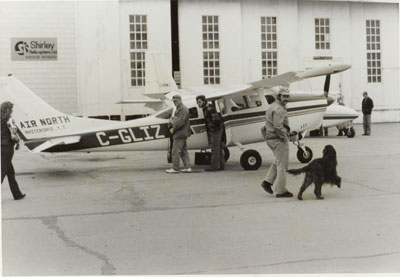 |
|
| Starting with a Cessna 206 “C-Gliz,” Air North flew charters for mining companies and later provided flight training. Photo: Air North
|
Between 1980 and 1996, Air North operated an eclectic array of piston-powered models. These included the Beech Twin Bonanza, Expeditor and Queen Air; the Britten-Norman Islander; the Cessna Super Skymaster; the deHavilland Beaver, Otter and Caribou; the Douglas DC-3 and DC-4; the Fairchild Husky; the Helio Super Courier; and the Piper Seneca and Navajo. The company initiated scheduled service in the mid-1980s with a DC-3 between Whitehorse and Fairbanks, Alaska. Several years later, the Whitehorse-Dawson City-Old Crow run was introduced.
Its first turbine aircraft arrived in August 1996, when the company bought a pair of Hawker Siddeley HS-748s. Their pressurized cabins and higher cruise speeds were a welcome improvement over the DC-3s. The 40-seat turboprops were put to use on the scheduled network that by then included Inuvik, N.W.T; Mayo, Yukon; and Juneau, Alaska. By the end of 1998, the fleet was totally turbine with a trio of HS-748s and a Beech 99.
Air North joined the Canadian jet club in May 2002, when it added two Boeing 737-200s. They arrived with a purpose – to provide scheduled service to southern gateway cities. On June 7, they began flying the Whitehorse-Calgary-Edmonton-Whitehorse loop every Monday, Wednesday and Friday. Two days later, the 737s initiated a roundtrip between Whitehorse and Vancouver on Sundays, Tuesdays and Thursdays. Air North offered a one-way fare on those routes that was less than half that charged by the incumbent mainline carrier. Almost a year later, on May 15, 2003, the company doubled its frequency on the Vancouver run to six trips per week.
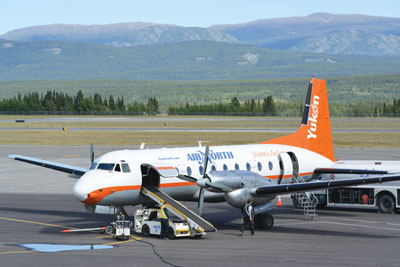 |
|
| A key reason behind Air North’s success is its close relationship with Yukon’s residents – not only as customers, and employees, but as owners as well. Photo: Simon Blakesley
|
On Oct. 1, 2005, Air North withdrew from the Whitehorse-Fairbanks route for the winter. The company had operated it twice weekly during the summer and reinstated it on May 15, 2006. In the meantime, it doubled the frequency on the Whitehorse-Inuvik run from three to six times per week.
During the summer of 2008, the company initiated fishing lodge charters from Vancouver to Masset and Sandspit on Haida Gwaii. The flights used 737s and HS-748s from June until Sept. In July of that year, a Boeing 737-200C was added. Equipped with a cargo door and a gravel deflector kit, it enabled Air North to access many more airfields in support of natural resource projects.
During 2010, two newer models of the Boeing 737, a -400 and a -500, joined the fleet. They provided more capacity for both the scheduled and charter services, as well as improved fuel efficiency. As a result of increased tourist traffic during the summer of 2011, Air North doubled the frequency of its Albertan route to six times per week from May 25 until Sept. 9. It also increased the number of flights between Whitehorse and Dawson City from six to eight per week, from June 13 to Sept. 9, using HS-748s.
On Sept. 5, 2012, Air North operated the Whitehorse-Dawson City-Old Crow-Inuvik-Dawson City-Whitehorse service with its 737 Combi instead of the usual HS-748. It was the first time that a 737 had visited Dawson and it demonstrated the ability to provide greater lift to those communities should it be required. Two months later, on Nov. 21, the airline carried its one-millionth passenger since it began 737-scheduled service a decade earlier.
This is now . . .
Today, Air North operates a fleet of 10 aircraft, consisting of two principal types: five Hawker Siddeley HS-748 turboprops and five Boeing 737 jets. The 737 fleet includes a 153-seat 400, two 122-seat 500s, a 120-seat 200 and a 200C. The latter can carry 120 passengers, or seven pallets as a freighter or a mix of passengers and cargo.
Air North derives its revenues from the following activities:
- Scheduled network. Using its HS-748s, the company connects Whitehorse to Dawson City, Old Crow and Inuvik. Between June and Sept., it operates a roundtrip from Dawson City to Fairbanks twice per week. Its 737s are flown between Whitehorse and Vancouver, as well as on the Whitehorse-Calgary-Edmonton-Whitehorse loop. Scheduled service connecting Whitehorse with Yellowknife (690 miles to the east) and Anchorage (500 miles to the west) has been considered, but never initiated due to a lack of demand. During 2012, the scheduled operations represented approximately two-thirds of Air North’s top line.
- Charters. Be it the movement of people or cargo, or a combination of the two, Air North’s fleet is able to respond to a wide range of customer requirements. The HS-748s can be configured to carry 40 passengers; 32 passengers with 4,500 pounds of cargo; 20 passengers with 6,500 pounds of cargo; 12 passengers with 8,000 pounds of cargo; or 10,000 pounds of cargo as a pure freighter. They can also be fitted with eight tanks that hold a total of 2,000 U.S. gallons/7,560 litres of fuel. The 748s regularly fly into the airstrip at Capstone Mining’s Minto mine, into Mayo in support of Alexco Resource’s Bellekeno mine, and perform the quarterly fuel airlift into Old Crow. The 737s also perform many missions, be it taking Yukoners south to Victoria, B.C., or Las Vegas, Nev.; flying tourists north from Vancouver to Haida Gwaii for fishing holidays; or moving oil sands workers between points within Alberta. Last year, charter work contributed roughly one quarter of the company’s total sales.
- Other. Air North also provides ground-handling services (fuel and baggage) for others carriers. Examples are the work done year-round for American Airlines at Vancouver and during the summer for Condor Flugdienst at Whitehorse. Last year, almost 10 per cent of the company’s revenues came from these activities.
The team responsible for executing the company’s business plan consists of approximately 300, most of whom are Yukon-based, with another 60 or so down south at Vancouver.
Mainline competition
During the winter months, November through April, Air North competes with Air Canada (AC) on the Whitehorse-Vancouver route. While AC operates three flights per day in each direction with 50-seat Bombardier CRJs, Air North operates two daily returns with Boeing 737s. Assuming the use of its 153-seat 737-400, Air North flies about 67 per cent of the weekly available seat miles on that route. During the winter, Air North is the only carrier that offers non-stop service between Yukon and Alberta.
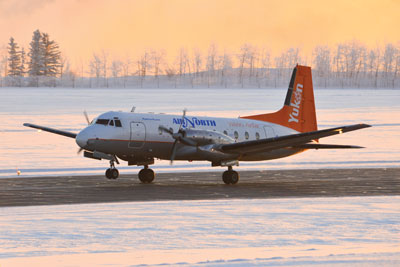 |
|
| Air North has provided scheduled services for most of its 36 years and has survived economic downturns that have doomed others.PHOTO: Air North
|
Like migratory birds in search of replenished fields to feed upon, Canada’s two mainline carriers return north in the spring.
WestJet Airlines provides a daily flight between Vancouver and Yukon’s capital with a 119-seat 737-600, and AC up gauges one of its three daily trips with a 93-seat Embraer 190. As a result, Air North sees its share of the weekly ASMs decline to about 50 per cent. As well, AC operates two daily return flights between Calgary and Whitehorse with 50-seat CRJs. This surge in seat capacity has a less than desirable impact on Air North’s overall load factor and yield.
Local ownership
A key reason behind the company’s success is its close relationship with Yukon’s residents – not only as customers, and employees, but as owners as well. The Vuntut Gwitchin First Nation’s 850 people own approximately 3,000 square miles of land around Old Crow in northern Yukon. Since 1999, their Vuntut Development Corporation has invested proceeds from their 1995 land claim settlement into local enterprises. Since Old Crow is not accessible by road or water, aircraft are the only means of delivering people and essentials such as food and fuel to its inhabitants. So, when co-founder Tom Wood decided to divest his interest in Air North, VDC recognized the opportunity to make a strategic investment. It astutely acted upon it by purchasing a 30 per cent interest in 2000, followed by an additional 19 per cent in 2001.
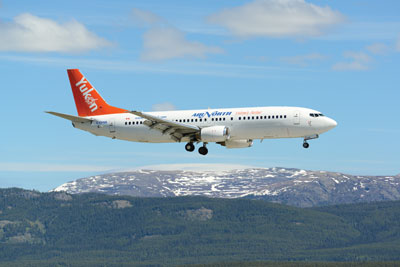 |
|
| Yukon's treasure trove of natural resources should keep Air North flying high for years.
|
When the company wanted to retire vendor financing on its first 737 aircraft in early 2002, it turned to local residents. It did so by using the Yukon Small Business Investment Tax Credit Program to issue Class C shares to individuals. Each investor received a one-time tax credit applicable to their Yukon taxes that was equal to 25 per cent of their investment. Each Class C share also provided a four per cent cumulative annual cash dividend and four flight segment tickets per year. After five years, the Class C shares could either be redeemed by the company or converted by the investor into Class D shares. While the Class D shares continue to provide four flight segment tickets per year, they are redeemable at Air North’s discretion.
How did this equity issue fare? Was it deemed to be too risky? Not at all. Six hundred and forty Class C shares were offered at $5,000 apiece and 544 investors took them up in short order, thereby providing $3.2 million for Air North. In March 2008, the company issued more shares at $7,500 apiece and used the proceeds of $6.1 million to assist in the acquisition of younger 737s.
Today, Air North is owned by Joe Sparling (50.3 per cent), Vuntut Development (48.4 per cent) and about 1,250 local residents (1.3 per cent).
Independent attitude
Reflecting the spirit of most Yukoners, the company has become a largely self-reliant operation. This is evident in many of its supporting activities such as maintenance, fuel supply, ticketing and inflight catering.
Within its three hangars at Whitehorse that provide 39,000 square feet of floor space, Air North performs most of the maintenance on its aircraft. The exception being the C checks on the 737s that are farmed out to MRO specialists in southern B.C.
Air North’s fuel is barged north from B.C. to Haines, Alaska. From there it is trucked to Whitehorse, where it is stored in the company’s tank farm until it is delivered to aircraft in its tankers.
The company’s call centre handles flight bookings. In addition to owning its computer reservation system, Air North is soon to be fully bookable in the Sabre Global Distribution System. This will enable the company to sell its seats through Expedia and Travelocity, thereby expanding its reach. Today almost half of its tickets are sold outside Yukon.
Finally, the light meals served aloft are prepared in the company’s flight kitchen at Whitehorse.
S.W.O.T. ANALYSIS
Air North
In order to better understand any business model and therefore appreciate how a company may fare in the future, it is helpful to perform a S.W.O.T. analysis (strengths, weaknesses, opportunities and threats). Doing so with Air North provides the following insights:
Strengths
Financial health
The company has been profitable in all but a few years since its inception. Having kept a disciplined eye on its borrowings, its balance sheet boasts a healthy debt/equity ratio.
Corporate culture
During the past decade, Air North’s headcount has grown tenfold from 30 to about 300. The company’s relatively low rate of employee turnover can be attributed to its efforts to attract and retain talented individuals who demonstrate a service-oriented attitude.
Local support
Whether they are customers, employees or shareholders (directly or indirectly), many Yukoners are associated with the company daily. Add to this the important logistical role played by the carrier and it becomes clear that Air North is woven into the fabric of Yukon’s economy.
WEAKNESSES
Small market
With only 36,000 residents, Yukon’s home market is roughly equal to that of Vernon, B.C. or Woodstock, Ont. While air transport is the principal mode that Yukoners depend upon to support their existence, it offers modest growth at best.
Costly location
Generally speaking, the higher a region’s latitude, the higher its cost of living. This translates into higher salaries for similar work performed in the south, as well as higher expenses for supplies sourced down south.
Basic infrastructure
Only two of Yukon’s 29 aerodromes have hard surface runways. That limits Air North’s use of its younger fuel-efficient 737s and largely dictates the utilization of its turboprops within the territory.
OPPORTUNITIES
Strategic partnership
An interline agreement, or a code-share arrangement, with one of the two Canadian mainline carriers would provide a win-win solution for Air North and its partner. The larger carrier would gain access Air North’s loyal customers in a cost-effective manner, while Air North would have the potential to attain an improved level of revenue per available seat mile on its southern routes.
Tourism traffic
Approximately 320,000 tourists visited Yukon during 2012. Increased interest in wilderness adventures, arctic ecology and aboriginal culture is resulting in increased numbers of visitors. Be they from North America, Europe or Asia, these travellers get to the territory via Vancouver, Calgary or Edmonton. Because of Air North’s presence in Whitehorse, these consumers provide approximately twice the impact on Yukon’s economy when flying aboard the local airline than they do when using a mainline carrier.
Resource exploration traffic
Five Yukon mines are expected to begin production over the next 10 years. According to the Conference Board of Canada, mining output in Yukon is forecast to achieve a compound annual growth rate of 10.7 per cent between 2013 and 2020.
THREATS
Increased mainline competition
Every summer, the two major Canadian airlines add capacity on their services to Whitehorse from Vancouver and Calgary. While Air North has so far managed to endure the associated pressure on profit margins, it has not gone unscathed. If additional seat capacity is introduced by the mainline carriers, the local carrier might have to consider strategies that would be less than welcome for itself and its stakeholders.
Weaker global economy
Demand for precious and basic metals is driven by economic activity around the world. Reduced demand results in lower commodity prices and in turn lower levels of exploration, development and production. Given that the mining industry is a key sector within Yukon’s economy, the territory and Air North would be exposed to any downturn.
Fleet renewal
The company estimates that the HS-748s can be operated for another five years. The deHavilland DHC-8-100 Dash 8 and the ATR42-300 are the most likely candidates to replace them. Both types have proven themselves with carriers operating “north of 60” in Canada and there should be suitable aircraft available when the time comes. There are no immediate concerns related to the replacement of Air North’s 737s.
What does this all mean?
Air North has adhered to a conservative business philosophy by:
- focusing on the needs of its home market
- providing a quality service at a competitive price that is also compensatory
- building a team of capable and customer-centric employees
- monitoring the level of financial leverage as assets are added
Joe Sparling provided clarity on the subject at a Standing Senate Committee hearing when he said, “At Air North, we describe our corporate objectives as endeavouring to operate safely and successfully while respecting the interests of our customers, our employees and our shareholders in exactly that priority.”
While many airlines have in the past bragged about achieving aggressive growth, they’ve often subsequently disappeared off the radar. Air North’s ascent has been much more gradual, but no less impressive over the long haul.
Final words
Given Yukon’s treasure trove of natural resources and photogenic topography, there continues to be a steady stream of people seeking to quench their thirst for financial gain, exotic adventure or spectacular scenery.
Having recognized the opportunity to provide the lift required to support such activity, Air North has evolved over almost four decades from being a tiny local bush operation into a logistical network upon which Yukon’s economy relies.
“Yukon’s Airline” is more than the company’s branding slogan. It is Air North’s mission statement that it accomplishes every day.